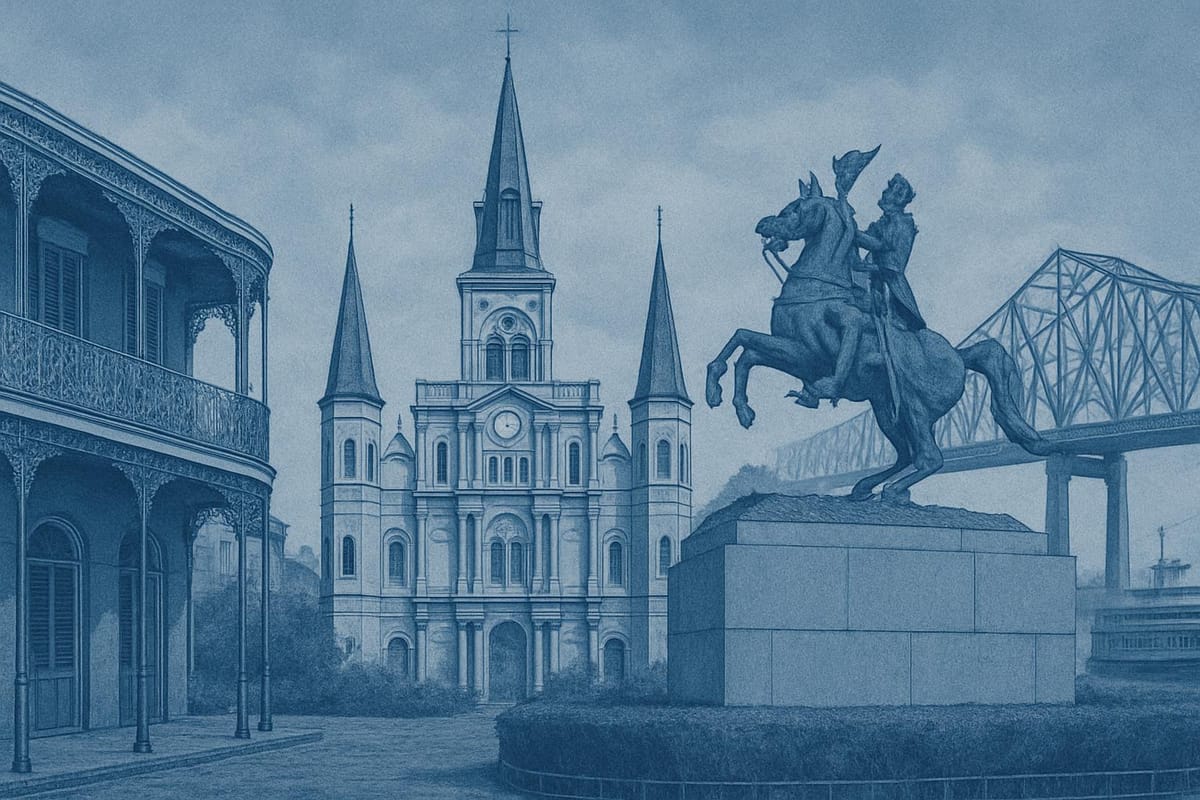New Orleans
Live jazz, Creole cuisine, French Quarter charm, beignets, riverfront views & Mardi Gras magic.

Important things to know about New Orleans
New Orleans, USA is a city of layered identity where history breathes through everyday life and the rhythms of music-especially jazz-shape streets and gatherings, creating an urban tapestry unlike any other in the United States. The city's character is a blend of cultural influences, from Indigenous and African roots to French, Spanish and Caribbean threads, producing a distinctive language of food, architecture and community traditions that influence how residents live, cook, converse and celebrate. Neighborhoods reveal a mix of shotgun houses, wrought-iron balconies and colorful facades that speak to centuries of change, while the proximity to the Mississippi River and surrounding wetlands informs both the economy and the local sense of place, connecting the urban core to water, trade and seasonal cycles. Culinary life is central to daily routines, where creole and local flavors are part of social rituals and family histories, feeding a reputation for bold, soulful dining without reducing the city to a tourist checklist. New Orleans is also notable for its linguistic and artistic creativity, where spoken word, visual art, and public performance intersect with community organizing and local entrepreneurship to generate vibrant grassroots energy. Challenges such as environmental risk and economic inequality have shaped a strong civic resolve, and stories of recovery and innovation are woven into the social fabric, highlighting resilience and communal care. For anyone seeking to understand an American city defined by contrasts and continuities, New Orleans presents a living case study in how place, memory and cultural exchange combine to sustain a singular urban identity.
Sightseeing hot-spots in New Orleans
New Orleans is a city where history and celebration live on every street corner, making it a top destination for sightseeing. Strolling through the French Quarter reveals ornate ironwork balconies, the iconic St. Louis Cathedral rising above Jackson Square, and the lively energy of Bourbon Street after dark. The city’s architecture and winding streets reflect rich French, Spanish, and Creole influences, while the mighty Mississippi River provides a scenic backdrop for riverboat cruises and waterfront photography. For travelers seeking quintessential New Orleans sightseeing, these historic neighborhoods offer both grand landmarks and tucked-away courts that reward exploration.
Music and food are inseparable from the city’s appeal, so any list of New Orleans highlights must include live jazz, intimate clubs, and legendary music venues where street performers and world-class bands create an unforgettable soundtrack. Food lovers can savor beignets, gumbo, jambalaya, and po’boys at bustling cafes and family-run restaurants, tasting the layers of Creole and Cajun cuisine that define the region. Seasonal festivals like Mardi Gras and year-round concerts make the city a dynamic spot for culture, while daytime markets and art galleries showcase local creativity and Southern hospitality.
Beyond the French Quarter, the elegant Garden District offers tree-lined avenues and antebellum mansions accessible by historic streetcars, and nearby cemeteries and museums-such as memorials that recount local and national stories-round out the sightseeing experience. Visitors seeking photo-worthy streets, culinary walking tours, or riverfront sunsets will find New Orleans rich with memorable stops and sensory delights. Thoughtful planning, comfortable footwear, and an openness to spontaneous music will help you discover the best sightseeing highlights of New Orleans and the many things to do in New Orleans that keep travelers coming back.
Hotels to enjoy in New Orleans
New Orleans, USA is a city where history and celebration meet, and the hotels here reflect that vibrant mix. From grand, historic properties near the French Quarter to contemporary boutique stays in the Warehouse District, lodging options cover every style and budget. Travelers often search for hotels in New Orleans that offer proximity to Bourbon Street, live jazz venues, and authentic Creole dining, and many properties respond with rooftop bars, courtyard pools, and curated local experiences. Whether you favor the charm of a restored mansion in the Garden District or the ease of a downtown hotel within walking distance of riverfront attractions, the city’s accommodations are infused with southern hospitality and uniquely New Orleans character.
For visitors optimizing their search for the best hotels in New Orleans, consider what matters most: historic ambiance, modern amenities, or convenient access to festivals and conventions. Many New Orleans hotels provide free Wi‑Fi, complimentary breakfast options, shuttle services to the airport, and on-site dining featuring regional flavors, helping guests enjoy both comfort and culture. Seasonal travelers should book early for major events like Mardi Gras and Jazz Fest, when demand spikes, and compare neighborhood vibes-the French Quarter for nightlife, the Garden District for architecture, and the Arts/Warehouse District for museums. By choosing a hotel that matches your priorities-luxury, value, or local flavor-you’ll find staying in New Orleans becomes an extension of the city’s music, food, and history rather than just a place to sleep.
Restaurants to try in New Orleans
New Orleans restaurants offer an intoxicating mix of Cajun and Creole traditions, where every plate tells a story of culture, history, and celebration. From the bustling lanes of the French Quarter to the quieter streets of the Garden District, dining in this city is as much about atmosphere as it is about flavor. Visitors and locals alike seek out the best restaurants in New Orleans to sample iconic dishes like gumbo, jambalaya, and shrimp étouffée, alongside beloved classics such as the po'boy and sweet beignets. Chefs here lean on local ingredients - Gulf seafood, seasonal produce, and robust spices - to create menus that range from rustic neighborhood fare to inventive fine dining. Whether you’re drawn by the drawl of live jazz spilling out onto the sidewalks or the promise of late-night plates on Bourbon Street, the city’s culinary scene is consistently praised for its authenticity and warmth.
Exploring restaurants of New Orleans means seeking out hidden gems and long-standing establishments that define the city’s flavor profile; many places blend family recipes with modern techniques for unforgettable dining experiences. Food writers and searchers often look for recommendations for the best places to eat in New Orleans, and for good reason: the city delivers everything from intimate bistros to lively seafood houses where oysters and crawfish shine. Expect attentive service, bold seasoning, and an unmistakable sense of place in every bite. To get the most out of your gastronomic journey, pair local specialties with a classic cocktail or a craft beer and savor how each restaurant contributes to New Orleans’ culinary legacy.
Best shopping stops in New Orleans
New Orleans shopping offers an intoxicating mix of historic charm and modern creativity, where French Quarter cobblestones lead you past art-filled galleries, antique dealers, and specialty boutiques. Wander down Royal Street to discover elegant antiques and original fine art framed by live jazz drifting from the sidewalk, or head to Magazine Street for six miles of eclectic shops, vintage clothing, and home décor sourced from local artisans. The French Market and Crescent City farmer stalls pulse with handmade jewelry, spice blends, and unique souvenirs that capture the city’s culinary and cultural spirit, while the Warehouse District showcases contemporary designers and curated galleries perfect for collectors hunting one-of-a-kind pieces.
Shopping in New Orleans is more than a transaction-it’s an immersion in a vibrant lifestyle where music, cuisine, and craft intersect. Expect friendly vendors, seasonal pop-ups during festival weekends, and specialty stores offering everything from Mardi Gras masks and Cajun spices to bespoke clothing and hand-blown glass. Whether you’re seeking upscale finds in Canal Place, boutique discoveries on Magazine Street, or budget-friendly treasures at the French Market, the city rewards curiosity with unexpected gems and stories behind every purchase. For travelers and locals alike, exploring the city’s diverse retail scene is an essential way to take home a piece of New Orleans’ rich heritage and creative energy.
Nightlife highlights in New Orleans
New Orleans nightlife pulses with a unique blend of history, music, and late-night revelry that keeps both locals and visitors enchanted. In the heart of the French Quarter, streets like Bourbon Street and Royal come alive with brass bands, street performers, and clubs where jazz and blues pour out of open doorways. From intimate jazz rooms and honky-tonks to high-energy dance clubs, the city's evening scene offers something for every taste: authentic live music, craft cocktails, and late-night dining that captures the essence of New Orleans culture. The legendary venues and curbside gatherings create an atmosphere where spontaneity meets tradition, making the city a top destination for vibrant New Orleans nightlife experiences.
Beyond the Quarter, the nightlife scene extends into the Warehouse District and along Frenchmen Street, where quieter bars and rooftop lounges offer a different, more local vibe. Hidden bars with speakeasy entrances, piano bars, and music halls provide alternative spots to enjoy world-class musicians and creative mixology. Visitors seeking the best of New Orleans nightlife should plan for late hours, embrace the city’s live performance calendar, and explore both famous streets and tucked-away venues to discover memorable nights filled with music, cocktails, and Southern hospitality.
Getting around in New Orleans
New Orleans offers a compact but well-connected airport and train situation that makes arriving and getting around the city straightforward for visitors: the primary air gateway is Louis Armstrong New Orleans International Airport (MSY), located in Kenner about 11 miles from the French Quarter with regular domestic connections and a growing number of international options, along with taxis, rideshare, shuttles and rental cars that typically reach downtown in 20–35 minutes depending on traffic; rail service centers on the historic New Orleans Union Passenger Terminal (NOUPT), where Amtrak Crescent provides daily long-distance service north to Atlanta and New York and the Sunset Limited offers tri-weekly service west toward Houston and Los Angeles, while local transit links including the iconic streetcar lines and RTA buses connect the station to the French Quarter, Garden District and business areas, making transfers between air and rail convenient for leisure and business travelers alike; overall the combination of MSY’s hub connections and NOUPT’s long-distance trains, plus frequent ground-transport options, gives New Orleans solid multimodal transportation connectivity for tourism, events like Mardi Gras, and regional travel.
Culture must-see's in New Orleans
New Orleans is a living mosaic of music, food, and history where every corner feels like a celebration. Wander through the French Quarter and you'll hear the heartbeat of jazz spilling from open doorways, brass bands leading spontaneous parades, and the call-and-response energy of street music that makes the city synonymous with live performance. The city's architecture - wrought-iron balconies, colorful shotgun houses, and grand Creole townhomes - tells stories of its layered past, while neighborhoods like the Marigny and Treme preserve traditions that shaped American music and culture. Culinary life in New Orleans is an attraction in itself; from steaming bowls of gumbo and plates of Cajun seafood to powdered-sugar dusted beignets, Creole cuisine draws visitors for authentic flavors rooted in African, French, Spanish, and Caribbean influences. The Mississippi riverfront and centuries-old plazas provide scenic backdrops for music, dining, and social life that are integral to the city's cultural identity.
Seasonal celebrations are another highlight, with Mardi Gras as the most famous expression of the city's festive spirit, featuring elaborate floats, masked balls, and colorful street parades that draw travelers from around the globe. But beyond Mardi Gras, a steady calendar of festivals - from intimate neighborhood gatherings to large public events - keeps the city vibrant year-round, showcasing everything from brass bands to emerging culinary artists. Local traditions such as the joyous second line parades and community-driven arts projects emphasize the city's resilience and community pride. For visitors and residents alike, New Orleans offers an immersive cultural experience where history, music, and food intersect to create an unforgettable sense of place that continues to influence American culture broadly.
History of New Orleans
New Orleans has a storied past that begins long before it became the lively city tourists know today. Founded in 1718 by the French Mississippi Company under the leadership of Jean-Baptiste Le Moyne de Bienville, New Orleans grew at the bend of the Mississippi River into a strategic port and cultural crossroads. The city’s early history was shaped by the Louisiana Purchase, Spanish rule, and a booming economy built on sugar and cotton plantations, which depended heavily on the transatlantic slave trade. This blend of French, Spanish, African, and Caribbean influences created a unique social fabric: the Creole and mixed-heritage communities produced distinct culinary, linguistic, and religious traditions. Architecture in the French Quarter and along historic streets showcases wrought-iron balconies, courtyards, and the legacy of colonial design, while the rise of jazz in neighborhoods like Tremé reflected a revolutionary musical synthesis. Over the 19th century and into the early 20th, New Orleans became synonymous with vibrant street life, parades, and Mardi Gras, festivals that combined deep-rooted customs with emerging American culture. The city also played notable roles during the Civil War and Reconstruction, and its ports linked local prosperity to national and international trade networks.
In the 20th and 21st centuries, New Orleans continued to evolve, facing challenges and celebrating resilience. The city’s cultural exports - from jazz legends to Creole cuisine and literary contributions - have influenced global perceptions of Louisiana and American culture. Despite economic ups and downs, New Orleans remained a magnet for artists, musicians, and food lovers seeking authenticity. The catastrophic impact of Hurricane Katrina in 2005 tested the city’s infrastructure and communities, exposing longstanding inequalities but also sparking an era of intense rebuilding and grassroots activism. Recovery efforts emphasized historic preservation, flood protection, and cultural revitalization, and while debates about gentrification and resilience persist, the city has shown a powerful capacity to adapt. Today, New Orleans balances its historic identity with efforts to foster economic development, tourism, and cultural sustainability; visitors and researchers alike are drawn to the music, the food, the festivals, and the ongoing story of a city that remains a singular melting pot of history, creativity, and perseverance.



